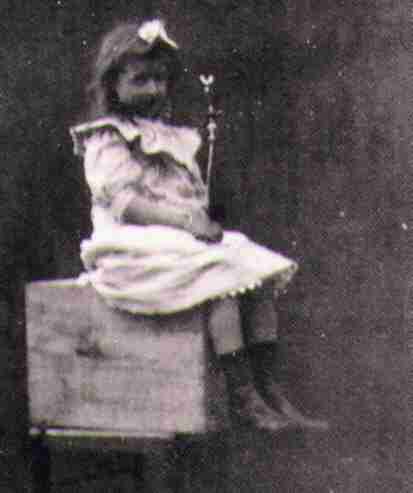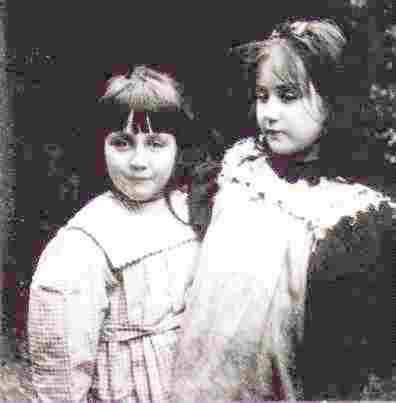
Figure 1.--This is one of the few photographs I know of with Jacques wearing a dress. He seems to have worn dresses until he was about 4 years old, after whuch he mostly wore sailor suits and gingham smocks.

Famed French journalist Emile Zola had two children. The girl, Dennis,
was born in 1889 and her younger brother, Jacques, was born 2 years
later in 1891. The children often played together as they were schooled
at home and did not mix with a lot of other children. One of the things
some authors have noted was the isolation of French children until they
were quite old. School was the first time many French children played
with other children. Even in the country during the summers some
children were mostly around adults. French families seem to have been
very close knit units. This was especially true of the Zola family. Jack
and Dennis' best friend seems to have been each other. They only occasionally played with other
children when friends visited. They may have been more isolated, however,
because their mother was Zola's mistress.
The two children and their mother accompanied Zola to exile in England (figure 2). Zola was forced to spend several years in exile following his expose' of the Dreyfus affair. The reason for the exile is the famous newspaper ariticle J Accuse!. It forced him to flee France and to live in exile for years, but eventually That article eventually added to his prestige exposing rampant anti-semitism in the French Army. The article eventually brought down the

Figure 2.--Dennis in this photograph is helping Jack learn how to ride a bike. He wears one of the sailor suits his mother favored so much. Note the length of his curls. |
The two children (Dennis and Jacques) are by his mistress, Jeanne and
not
his wife, Alexandrine. This doesn't mean he had a poor relationship with
his wife. The French being French, this did not cause a scandal--in fact
Alexandrine accepted it. When Zola visited the children, he often wrote
his wife about how they were doing and sent along photographs of Dennis
and Jacques playing or engaging in other activities. Alexandrine was
childless and she psychologically adopted the children of his mistress.
After his death she provided for the children and their mother.
Around the time his children were born Zola developed an interest in
photography. Because of this there exists today many photographs of Zola's
children. None of the photographs I've seen show Jacques younger than 3
and most are of him at about 4 or
5 years or older and almost none show Jacques in a dress.
The children were very close. They were schooled at home and often played together. Unlike a few years earlier, boys and girls were no
Most of the available photographs of Jaques as a younger boy
show him with extremely long hair. Only
one photo, however, shows him with ringlets, so
I think his hair was curled only on special occaisions. There is one
exception. The photograph of Jacques in Rome wearing the large sailor
hat and a coat over the dress appears to show him with short hair. I have no
idea why this would be.
As he became older his hair was cut shorter, first to his chin in a
pageboy bob and later in a Dutch boy cut. The first bob and bangs had his hair much longer at the sides than the Dutch boy bob he finally wound up with.
Interestingly a lot of the photographs of Jacques wearing smocks show him with bobbed
The available photographic record show Jacques through about 10 years
of age in 1901. At that age he still wears Dutch boy bangs. I'm not
sure at what age his hair was finally cut to a more mature look. As the
children were schooled at home, there mother had a great deal of latitude
in how their hair was cut and what they wore.
I do not know what opinion if any Jacques had about how his hair was cut.
Children at the turn of the century generally had little say in their clothes
or how there hair was cut. This does not mean, however, that they did not have
very definite opions on such matters.
Jacques as a small boy was oufitted in dresses, as was the fashion of the day. There are few early images of him, however, wearing dresses. One of the few photograph of him in a dress shows his father photographing
Emile traved to Rome with his father when he was about 4 years old. He
is wearing a coat over what looks like a white dress. He wears white white
socks and strap shoes with pompoms in addition to white gloves. The white
gloves are interesting. Gloves used to be an important element of formal dress than is
currently the case.
After emerging from dresses, Jacques mostly wore sailor suits. Some of his sailor suits appear to have been romper outits with features of a middy blouse, a sailor collar with "v" front and box collar at the back. One picture of Jacques in a romper-like sailor suit shows Dennis in a dress and pinafore. Some of the other photograps such as the one with Dennis helping her little brother learn to ride a bicycle also show her wearing a pinafore. Pinafores were very commonly worn by girls at the turn of the century. (Earlier in the 19th century it was more common for little boys to wear pinafores as well.)
Jacques wears a romper outfit with large ruffled collar blowing bubbles
(figure ?). Actually it is a bit hard to determine if Jacques outfit is
a romper outfit or a sailor suit with above the knee knickers. Almost all romper
outfits had above the knee pants.
Jack's mother does not seem to have been very imaginative about his
outfits.
Younger boy: Most available photographs show him as a younger boy in white or light-colored
sailor suit. His suits have above the knee knickers
which he wears with either short socks or long black stockings. As he
got older he began wearing his knickers just below the knee. (This seems
to have been a popular fashion in
France at the turn of the century. A
contemprary
of Jacques recalls wearing such an outfit to school.) Jacques for most
of his boyhood wore sailor suits of various forms. Some when he was younger
were rather like rompers. As a younger boy the middy blouse had some
non-sailor like features like ruffles or even lace trim.
Several photos show the children with toys. In one of these he is holding what we would think of today as a
girl's doll. It interesting to note that
he is not holding the doll like a girl, but like it was a toy solder,
truck, or any other boyish toy. Much like the way American boys play with
GI Joe dolls or teddy bears.
Some photos show Jacques at about 6 or 7, wearing a knee length
smock with a sailor-type box collar trimed in lace. In some photographs Jacques wears a back-tying cloth strip to
belt the smock at the waist. Presumably it was tied in a bow at the
back. In many other images his smock is worn
without any waist belt and falls loosely to just below the knees. I'm
not sure if his mother brought different styles and had a preference on
the matter or if on some days the belt was just not used. I don't think
that Jacques himself decicded on the matter.
His smocks were back buttoning and the waist belt was done up at the back
so he woukd have needed help in putting on his smock.

Figure 8.--Jacques is pictured here with his older sister Dennis. He wears a gingam smock. As a boy, almost all of the available images show Jacques dressed in either a smock or sailor suit. |
Several other images show Jacques wearing a smock. He appears to be older than many of the
images above of him playing in sailor suits. His hair has been cut and he is shown wearing
Dutch boy bangs. He looks to be about 7 or 9 years old.
His smock is back buttoning and has a large collar edged with ruffles.
I'm not sure just when his mother would decide for Jacques to wear his smock and when he would not have to wear it. The smock appears to be an informal garment, perhaps worn mostly at home. Some of the photographs with him wearing the smock may have been taken in England. He appears to be wearing the knickers, probably as part of a sailor suit, to which his mother was so partial. The smock is almost the same length as his knickers which look to be below the knee length. I have no information on what he thought about his smocks, if anything. He seems to have been in a rather happy mood in the photographs so he does not seem to have had any great objection. Notice his stylish hat which has been carefully placed at the foot of his mother's long
Smocks by the turn of the century appear to have been a much more common
garment for French boys than for boys in Britain and America. French school
boys wore smocks to school through elementary school. Thus it appears
likely that it would be more common for boys to wear smocks after school
than was the case in Britain and America. School smocks were mostly black
or dark blue so they would not show ink stains. (There were no ball point
pens in those days. Actually I can still recall fountain pens and ink wells
in scholls during the late 1940s and early 50s.) I'm not sure how common
that gingham smocks like the ones
worn by Jacques were. Older boys weraring blue school smocks might have
viewed gingham smocks as for little boys.
As was the case at the turn of the century, Jacques was usually
outfitted in an appropriate hat. The Victorians and Edwardians almost
never left their house without a hat or cap and this also included their
children. The Zola's were no exception. While his father seems to have
usually had Jacques
take off his hat for the photograph, mother would oftem make sure that it
was displayed, sometimes prominently in the photograph.
Jacques mother seems to have liked broad-brimmed sailor hats. One photograph
taken in 1894 shows him in a coat over a white dress with white socks and
strap shoes sporting an enormous wide-brimmed sailor hat. This has to be one of
the largest hats I have ever seen on a small boy. A broad-brimmed sailor hat
is also displayed in the backgrond while Jacques is having tea with his sister and mother.
Jacques appears to have also worn a straw hat, but not a wide-brimmed
sailor hat, when he wore smocks. Note the hat that his mother has caarefully
placed at the foot of her dress in the photograph of a smock-clad Jacques
reading a book with his mother (figure ?).
I am not sure when Jacques stopped wearing smocks and sailor suits nor
when his hair was finally cut short.
I am not sure about Jacques adult life.
References:
F.W.J. Hemmings, The Life and Times of Emile Zola, Charles
Scribner's & Sons, New York, 1977.
Navigate the Historic Boys' Clothing Web Site:
[Introduction]
[Chronologies]
[Style Index]
[Biographies]
[Bibliographies]
[Contributions]
[Boys' Clothing Home]
Navigate the Historic Boys' Clothing Web chronological pages:
[Early 1800s]
[The 1840s]
[The 1880s]
[The 1890s]
[The 1900s]
[The 1910s]
[The 1920s]
[The 1930s]
Navigate the Historic Boys' French pages:
[Main French page]
[French school uniforms]
[Smocks]
[Hair bows]
[Long hair]
[Dresses]
[Blouses]
[Long stockings]
